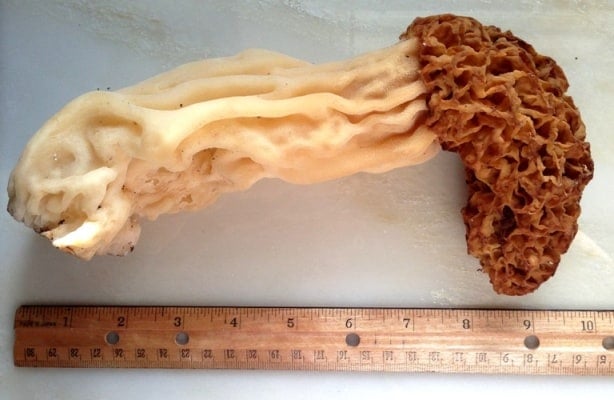A couple years ago I started running across this name online of a type of morel, morchella crassipes: the bigfoot morel. Then, while perusing through the bible of mushroom guides: David Arora's Mushrooms Demystified, I noticed a picture of him holding two massive black morels on the back cover of the book.
I thought to myself: "I wish I could find a giant morel, that would be amazing!". Well a couple years later I have found plenty of them, and suffice to say that If you know what a dead elm tree looks like, you can find a bigfoot morel.
I'm not a mycologist, but here is some of the info I've picked up regarding morchella crassipes:
- It is humongous! Dwarfing all other morels you have ever found
- The stem is buttressed, trapezoidal, or triangular
- The stem is hugely un-proportionate to the cap, unlike most morels.
Habitat
These grow where you'd expect regular morels. I find them with dying oak trees, but my best spot is around living cottonwoods in Minnesota, they're not exactly common though. When a batch of 100 lbs of morels came into the restaurant I worked at years ago there were a few bigfoots in the bunch, probably about 5 or 6 out of a few thousand. It isn't that they grow in different places than morels, it is the timing that is important. From my experience, bigfoot morels signal the end of the morel season here in Minnesota.
Cooking
They cook just like any other morel, although they would be cumbersome to cook whole. You could cut them in half and serve as a gargantuan fried mushroom steak for two, maybe with a candle-lit table.
From my experience, older morel stems can get a little bit tough, so breading and frying would be a good way to go if you want to cook one.
My coworker brought in a big foot last year, I dried it whole for him, he says he is going to give it to his daughter when she graduates, which is good for a laugh. Personally, I dry mine most of the time, and then use them like any other dried morels.


Arlynne Eisner
I spend most of my free time foraging. Your site is incredible.
Alan Bergo
Glad you're enjoying it.